| India Profile » Monuments and Temples in India » Churches of Goa | |
Churches of Goa | |
 | |
|
The churches in Goa are built during the period between16th and 17th century AD and are a legacy of the Portuguese. They are generally built of laterite and lime plaster. The famous churches of old Goa comprises of Se' Cathedral, Church and Convent of St. Francis of Assisi, Chapel of St. Catherine, Basilica of Bom Jesus, Church of Lady of Rosary and the Church of St Augustine. The churches display a combination of the Renaissance and Baroque styles. These churches and convents in old Goa are architectural masterpieces and are listed in the UNESCO World Heritage Site. Even today, these churches stand tall with plenty of historical importance. They have always attracted immense interest for tourists whether Indian or foreigners. Se Cathedral Se Cathedral is the largest church in Asia. The cathedral in Old Goa was built in the 16th century AD by the Roman Catholic rule of Goa under the Portuguese rule. The original building was built of mud, stones and straw. It was dedicated to St. Catherine because on 25th November, St. Catherine's Day, Alfonso de Albuquerque captured Goa. It underwent several alterations afterwards and a second church was built in 1515 AD. The status of the church was elevated to that of a cathedral with the establishment of the Diocese of Goa. This structure was also demolished and a new building was made. The construction Cathedral began in 1562 and completed in 1652. Dom Francisco Continuo, the Count of Redondo started its construction. The final construction was supervised by Antonio Argueiros and Julio Simao, Chief Engineer to India. The Cathedral is built partially in Tuscan and Doric style from the exterior and in the Mosaic-Corinthian style from the interior. It had two bell towers initially but the northern tower collapsed on 25th July 1776. The existing tower has 5 bells including the golden bell. The Golden Bell is the biggest bell in the world. There are four chapels on each side of the Cathedral along with the main altar. The first chapels on the right is dedicated to St Anthony, the second to St Bernard, the third to Cruz dos Milagres or the Miraculous Cross and the fourth to the Holy Ghost. The first chapel in the left is dedicated to Nossa Senhora de Necessidades, the second to St Sebastian, the third to the Blessed Sacrament and the fourth to Nossa Senhora de Boa Vida. There are six altars on each side of the cathedral. The principal chapel has three altars. The altarpiece is lavishly decked with the engravings. There are three niches, one above another. The images on these niches are of St Catherine, Nossa Senhora d'Assumptio and the Crucified Christ. The image of St. Peter and St. Paul stands on both side of the altar. There are engravings of depicting the martyrdom of St Catherine of Alexandria as well. 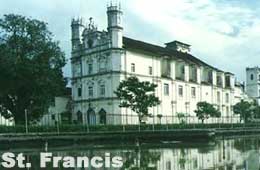 Church of St. Francis Of Assisi, Old Goa Church of St. Francis of Assisi is situated to the west of Se Cathedral in the Convent of St. Francis of Assisi. These were made by the Franciscan mendicants, 8 of whom came to Goa in 1517 AD. It was initially a chapel and modified into a church in 1521 AD, dedicated to the Holy Spirit on 2nd August 1602. To begin with, the convent was made by the mendicants as their residence and underwent alterations in 1559 AD. The Portuguese government closed the convent in 1835 AD. The church has been converted into a museum by the Archaeological Survey of India in 1964. The church displays artifacts, paintings and pieces of Hindu temple sculptures from Goa. The architecture is a combination of the Tuscan style from the exterior and the Mosaic-Corinthian style from the interior. The interior of the church is gilded with the scenes from the Bible and wall frescoes show intricate floral designs. The niche of the fa�ade holds the statue of St Michael and a wooden statue of St Francis Assisi decorates the pedestal in one of its chapel. A heavily carved niche with tabernacle supported by four evangelists can be seen in the main altar. Two huge statues, one of St Francis Assisi and the other of the Jesus on the Cross, are placed above the tabernacle. Chapel of St Catherine A narrow road runs to the west from the Church of St Francis of Assisi leads to the Chapel of St Catherine. It is a living example of the subjugation of Goa by Alfonso de Albuquerque. It is dedicated to St Catherine because Albuquerque captured Goa on the St Catherine's Day, i.e., 25th November 1510 AD. The chapel was enlarged by Governor Jorge in 1550 AD. The status of the chapel was elevated to that of a Cathedral vide a Papal Bill by Pope Paul III in 1534 AD. Till new cathedral, Se Cathedral, was built, this Chapel remained a cathedral. There was the Royal Hospital nearby established by Albuquerque in 1511 AD and was renovated in 1952. The altar is dedicated to St Catherine upon which stands the statue of Our Lady of the Piety. Basilica of Bom Jesus
The Basilica of Bom Jesus is the most august and famous of all the churches in Old Goa. It contains the relics of St. Francis Xavier, Patron saint of Goa, Apostle of the Indies. He was known as Goencho Saib by most of the people of Goa. The construction of the church began on the 24th November 1594 AD from the funds bequeathed for this purpose by Dom Jeronimos Mascarenhas. It was blessed by the Archbishop Dom Fr Aleixo de Menezes on the15th May1605 AD. It became the first church in India to be elevated to the status of a minor basilica in 1946. The three storey structure is combination of Doric, Corinthian and Composite style of architecture from the exterior. It is built of black laterite stone. The fa�ade is divided into four parts. The lowest part contains three graceful entrances. The part above it has three large windows corresponding to the three entrances. The third section has three circular windows and the fourth part forms a quadrangle decorated lavishly with arabesque. All the sections are decorated with pillars and carvings on basalt brought from Bassein in north Goa. The interior of church is made of Mosaic-Corinthian style and is noteworthy for its simplicity. Three rows of windows are rising one over another from each side besides those of the choir and corresponding circular ones. The windows in the second row have a protruding balcony skillfully attached to them. The entrance is beneath the choir and is supported by columns. The body of the Basilica is spacious. The relics of St Francis Xavier were kept in this chapel from 1623-55 AD. The Blessed Sacrament was earlier kept on the main altar under the statue of St Ignatius and now is preserved in a gold tabernacle. A cenotaph of gilded bronze to Dom Jeronimos Mascarenhas, Captain of Cochin and Ormuz and the benefactor of the church, is on the northern wall near the side wall. The church is dedicated to the Infant Jesus and is exquisitely decorated. The infant Jesus is shown under the protection of St Ignatius of Loyola, the Founder of the Society of Jesus. The statue of St Ignatius is almost 3 m high. The side have altar to Our Lady of Mercy and St Michael. The Liturgical altar was set up by assembling the old discarded altars and was inaugurated on 12th March 1965. The chapel and tomb of St Francis Xavier is to the south of the church. The body of St. Francis Xavier was brought here from the College of St Paul after his canonization in 1624 AD. It was shifted to its present location in 1655 AD. The chapel has three doors on the east, west and south. A huge picture of the saint is hung on the last door. The chapel is decorated with 27 pictures representing the life and miracles of the saint. The mausoleum is a three-tiered bier built by the Duke of Tuscany (1670-1737 AD) in return for the pillow on which the head of St. Francis Xavier rested for many years after his death. Giovanni Batista Foggini from Florentine designed the structure and was completed in1698 AD. It arrived at Goa on 16th September 1698 from Florence, Italy and was erected between 14th October and 9th November 1698. On the top of the bier lies the Silver Casket, which contains the relics of the saint. The casket was constructed by Gaon silversmiths under the supervision of Fr Marco Mastrilli S.J. it is also known as Mastrillian casket. The money for its construction came from the donation in Goa and elsewhere. It was completed on 2nd December 1637 on the feast of the Saint. It was crowned by a cross standing on a pedestal with the figures of two angels on both the sides, one near the head holding a heart with a halo and the other near his feat bearing the motto "Satis est, Domine, Satis est" meaning "It is enough, O Lord, it is enough!". It is believed to be the most common utterances of the saint. The plates on the sides of the casket have been removed to make the relics visible through the inner glass/ crystal urn into which the relics were placed in 1955. The crystal urn was ordered after the exposition of D. Jose Costa Nunes, Patriarch of Goa in 1952, it was decided that the sacred relics should not be touched directly anymore. The crystal urn was made in the Casa Brandizzi at Rome and was brought to Goa on January 30th 1955. The relics were placed in the crystal urn first and then into the silver casket on February 13th 1955 and sealed. The old wooden coffin with its three keys is now kept in the museum at the Professed House of the Jesuits.
The Relics of the Saint show him to be clad in rich robe with the coat of arms of the queen of Portugal, Maria Francisca de Sabeia. A gold medal declaring the Saint as the Defender of the East is by the side. A staff covered in gold and 160 emeralds was placed on the orders of the King of Portugal Pedro II (1683-1706 AD) on 23rd October 1699. Every year, on the 3rd December, the day of the Feast of St. Francis Xavier, the saint's finger is displayed to the public. The exposition of the body of St. Francis Xavier is held once every ten years and the last being in 2004. Church of Lady of Rosary The Church of Lady of Rosary stands on the top of the western side of the Holy hill or Monte Santo overlooking the Mandovi river and Divar Island. This is supposedly the very place where Alfonso de Albuquerque led his troops to victory in 1510 AD and a plaque was placed with the inscription in the 1950's. Its status was raised to a church in 1543 AD and it was entrusted to the care of the Franciscans. The people held it in great reverence as St. Francis Xavier used to teach catechism here every evening to the public who flocked together at the sound of a little bell he rang.
The fa�ade of the church appears like a fortress openings in its wall to look out for the invaders. The design is simple. The tombstone of Garcia de Sa, one of the earlier Governors of Goa lies in front of the altar. Church of St. Augustine The convent was constructed by 12 Augustian friars in 1572 AD immediately after their arrival at Goa on 3rd September 1572. the church was constructed in1602 AD. Both the church and the convent are in ruins. The church was in good condition till 1835 AD when it was abandoned because of the ban on the religious orders by the Portuguese government. The vault of the church collapsed in 1842 AD and the fa�ade on 8th and 19th August 1931. only the bell tower without the bell is left today. The bell was taken to the Fort Aguada Light House initially from 1841-71 AD. In 1871 AD, it was moved to the church of Our Lady of Immaculate Conception at Panaji where it is functioning even today. |
|
 |
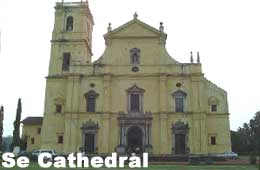
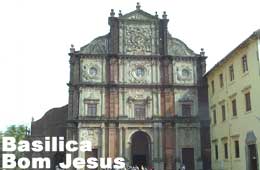
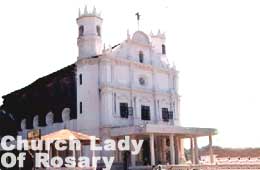
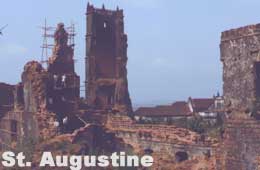 It is a fine example of true "Manueline" style architecture of the early Portuguese. Its interior is simple and has five altars. The main altar bears the image of Nossa Senhora de Rozario or Our Lady of the Rosary.
It is a fine example of true "Manueline" style architecture of the early Portuguese. Its interior is simple and has five altars. The main altar bears the image of Nossa Senhora de Rozario or Our Lady of the Rosary.